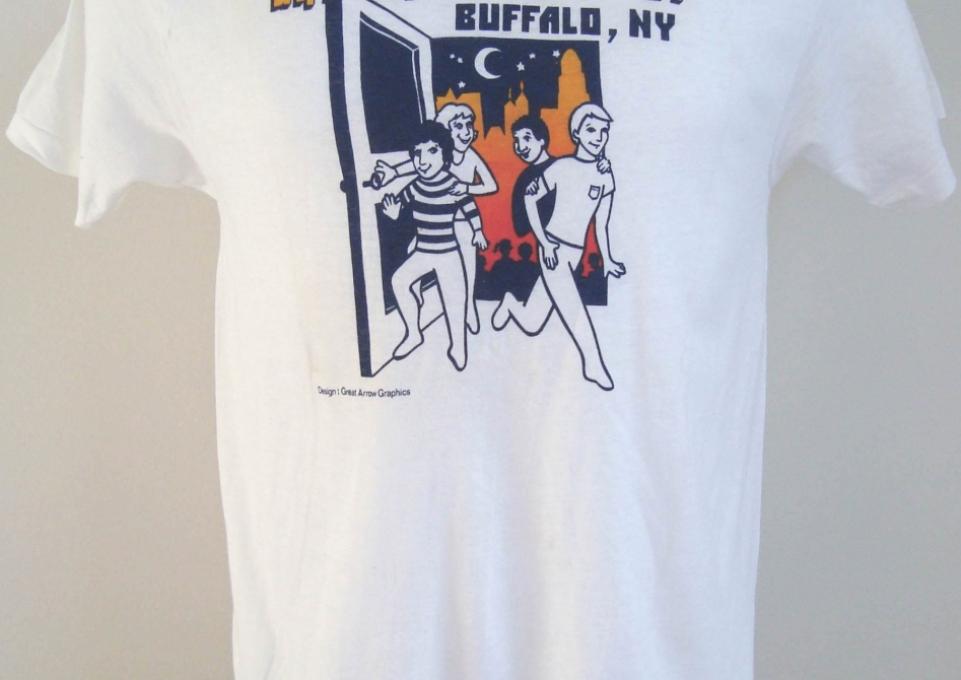
T-shirts from the Dr. Madeline Davis LGBTQ Archive of Western New York are now included in a national digital exhibit, Wearing Gay History.
The digitized images were created by Hope Dunbar, processing archivist at E. H. Butler Library. “When I found the T-shirts in the LGBTQ collection, I was excited,” she said. “But I was also concerned, because T-shirts are tricky to conserve. The images printed on them may crack if they are creased. I wanted to photograph them so people could see them without having to handle them.”
Dunbar first worked with special collections at the renowned Newberry Library in Chicago. “It was the first time I felt I was really touching history,” she said, “and it impressed upon me the importance of stewardship. Somebody made the time and effort to care for the material, or it wouldn’t be there.”
That “somebody” for the LGBTQ collection was Madeline Davis, chief conservator and head of preservation in the Buffalo and Erie County Public Library System (retired). She was active in the Mattachine Society of the Niagara Frontier, the first gay rights organization in the region, in the 1970s. Davis started the archive collection in her home and transferred it to the Archives and Special Collections at Buffalo State in 2009. In 2016, an anonymous donor made a $50,000 gift through the Community Foundation for Greater Buffalo to assist with digitizing the Madeline Davis collection.
Dunbar values the T-shirts for several reasons. “For one thing,” she said, “many were designed for a one-time event, so they are the only item to document that event. As physical objects, they help you realize that history is something that happens to real people. And a T-shirt is so intimate. It’s a physical representation of an idea, an idea that you’re choosing to put on your body.”
Dunbar wasn’t the only person to recognize the unique place held by T-shirts in chronicling gay history. Wearing Gay History showcases a collection of such T-shirts from around the United States. Buffalo State’s collection was added to the website in December 2016.
To create the images, Dunbar borrowed a dressmaker’s form from the Fashion and Textile Technology Department, hung each shirt, steamed the wrinkles out, and took several photographs. “I could only work a couple of hours each day,” she said, “because that was when the sunlight made the photographs possible.”
Why go to so much effort?
In an era when Hallmark publishes wedding, anniversary, and new-baby cards for same-sex couples, it’s hard to imagine a world in which police raided gay bars and arrested patrons for dancing with a member of the same sex. Rod Hensel, coordinator of the Silver Pride Project at the Pride Center of Western New York, said, ““Gay people in their 50s and 60s know intellectually that things have changed, but our subconscious memories include being labeled as criminals and mentally ill. Probably 70 percent of us were cut off by friends or family after coming out, and now, as we age, we still don’t have those relationships. Attending openly gay events in the early 1980s took courage. Putting on one of these T-shirts was a huge personal step.”
That’s why Dunbar believes archives are essential. “It’s a way to preserve these records created by individuals who fought for certain rights,” she said. “People do have the ability to change systems. Seeing past victories creates a possibility of hope for the future.”
The Archives and Special Collections invites you to donate your T-shirts to this collection by contacting Daniel DiLandro, college archivist and special collections librarian.
Photo credit: Dr. Madeline Davis LGBTQ Archive of Western New York.
